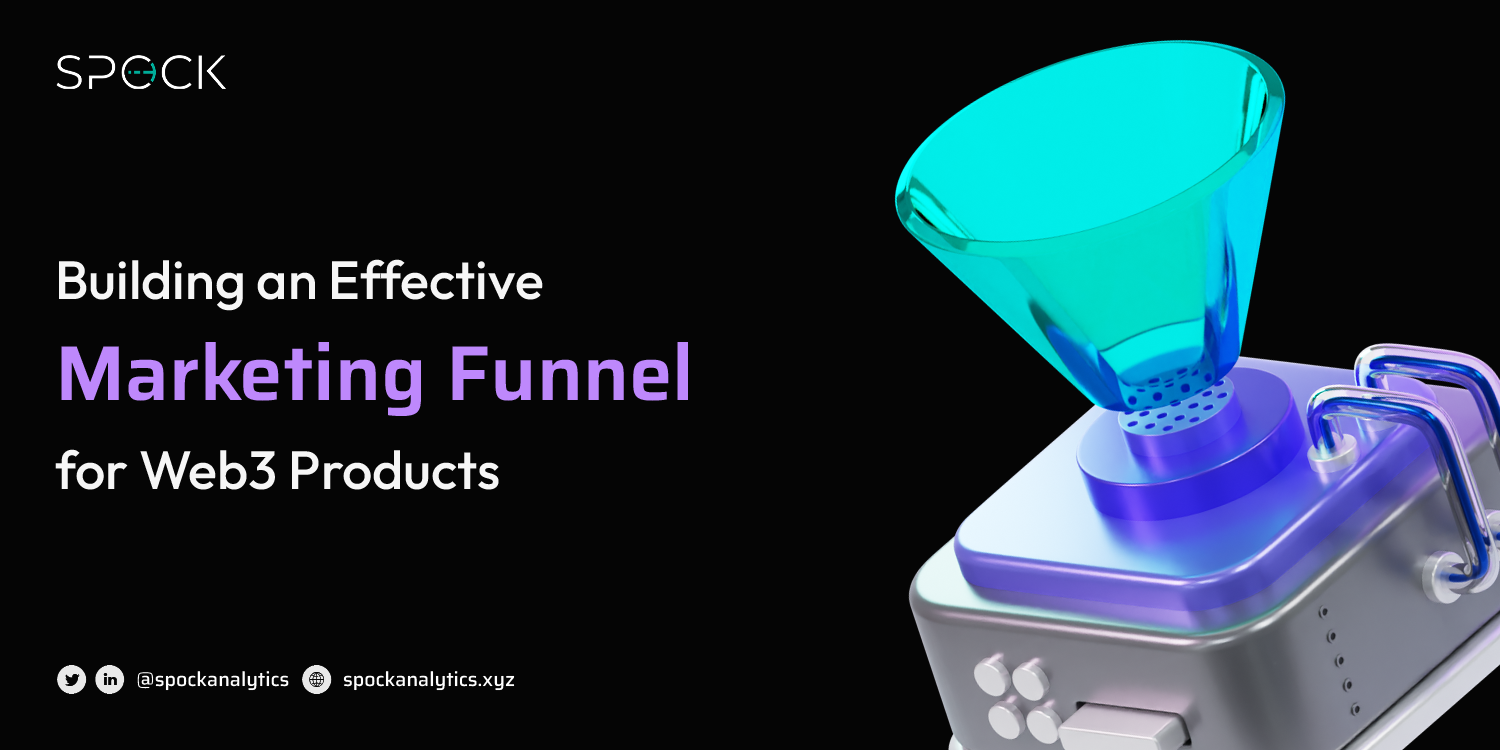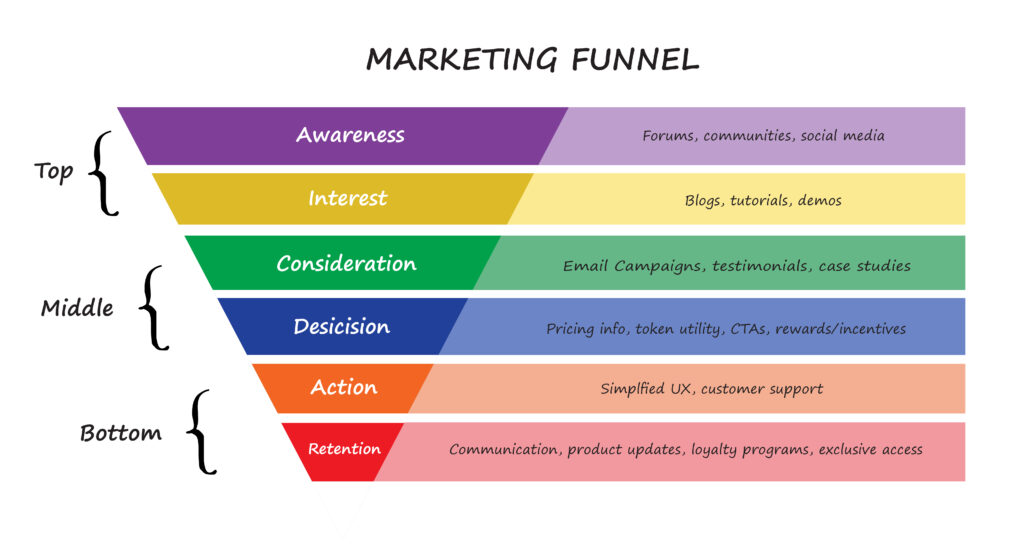
Picture this: You identify a problem in the market and have an idea for a Web3 product. This product seems like the best solution to the problem statement. And you immediately start working on developing it alongside your team. You are bullish on this product because you know its worth and potential. After working tirelessly days and nights, you launch the first version. Now it is time to onboard users. But due to some reason, you are unable to do so organically. You are frustrated because you can’t identify what you are doing wrong. You are carrying out marketing initiatives and populating your social media presence yet somehow, it is still not working. Let me tell you why. Because you have not built the right user journey. You have not focused on building a marketing funnel that is going to convert your audience into paying customers. The marketing initiatives are in vain if they are not contributing to the goal of onboarding users onto your product. In this article, we will take a step-by-step approach to building a marketing funnel that works for your Web3 product. A marketing funnel or sales funnel, is a conceptual framework to guide users through a series of well-defined stages. From initial awareness to eventual conversion and advocacy. By understanding the unique characteristics of Web3 marketing, we can optimize each stage of the funnel. This helps to drive desired outcomes and cultivate a loyal community. Furthermore, it develops an ecosystem where users are not just passive recipients but active participants in your project. In the rapidly evolving world of Web3, where decentralized technologies and blockchain-based ecosystems are reshaping the digital landscape, the need for a marketing funnel becomes even more critical. Here are some key reasons why a marketing funnel is essential in the Web3 environment: Web3 products and services often come with unique complexities compared to traditional offerings. Their decentralized nature, token economics, and integration of blockchain technology can be unfamiliar to potential users. A marketing funnel helps simplify and guide users through the complexities. It provides clear information, education, and resources at each stage of the customer journey. Web3 has introduced a paradigm shift emphasizing decentralization, transparency, and user empowerment. However, this also means users must trust the underlying technology, the project team, and the community. A well-structured marketing funnel allows businesses to establish credibility. It does so by providing transparent information, case studies, user testimonials, and thought leadership content, fostering trust among potential users. Web3 is a nascent field. Many potential users may not be familiar with the concepts, benefits, or use cases. Consequently, a marketing funnel provides an opportunity to engage and educate users about your product. Its value proposition, features, and potential impact. Through informative content, interactive demonstrations, tutorials, and engaging storytelling, businesses can generate interest and build a knowledgeable user base. In the Web3 space, community and user engagement play a vital role in the success of a project. A marketing funnel allows businesses to nurture relationships with potential users. It involves them in the project journey, and building a loyal community. Hence by providing ongoing communication, updates, and opportunities for feedback, businesses can foster a sense of ownership and collaboration among users. Token economies are central to many Web3 projects, where users engage with and utilize project-specific tokens. A marketing funnel helps users understand the value and utility of these tokens. It guides them through token acquisition, usage, and participation in the project's ecosystem. It enables businesses to showcase the benefits of token ownership and incentivizes users to actively contribute and become part of the project's growth. With a well-designed marketing funnel, businesses can optimize conversion opportunities at each stage of the customer journey. From clear calls to action (CTAs) and streamlined onboarding processes to personalized offers and incentives, a marketing funnel effectively guides potential users toward the desired action. Whether it is making a purchase, participating in a token sale, or joining a community. To put it simply, Marketing Funnel is a way to streamline all your marketing activities to gain maximum ROI. They serve as a proven way to improve your marketing ROI. Marketing funnels can save you time, money, and effort. They make your initiatives more focused and better targeted toward your preferred audience. Moreover, by aligning marketing efforts with the unique characteristics of Web3, businesses can maximize their reach, attract the right audience, and ultimately create a thriving ecosystem around their Web3 product. The marketing funnel lies at the core of any effective marketing strategy. It typically consists of several stages, each representing a different level of user engagement and intent. Here are the stages of a traditional marketing funnel: Now that we are familiar with the stages of a marketing funnel, let’s dive deep into each one and understand how we can leverage them to supercharge our Web3 products and drive conversions. At the top of the funnel, the goal is to create as much awareness of your product as possible. You need to attract the attention of potential users of your product within the Web3 ecosystem. This is the time to leverage various Web3-specific marketing channels such as blockchain forums, communities, and social media platforms specifically Twitter, and develop effective content marketing strategies. Remember to tap into every channel that your potential customer is using. That way, through one platform or another, they would get to know your product. You will also be creating multiple touchpoints with your potential customer. And after repeatedly seeing your product, they would get curious about it and transition into the Interest Phase. Make sure that you highlight the unique features and benefits of your Web3 product. And do so in a way that is relatable to your audience. Once your potential user is aware of your Web3 product or service, the focus shifts to generating interest and building engagement. This is the ‘get-to-know’ phase of the user journey in your product. At this point, you would need to provide valuable information and educational content about specific use cases, functionalities, and advantages of your product. Focus on how your product differentiates from your competitors and how it can be valuable to your target market. This can be achieved through blog posts, whitepapers, video tutorials, interactive demos, and showcasing real-world applications to captivate the interest of potential users. In addition, get interactive in web3 communities or build your community to foster your user’s interest. This is the make-or-break stage in a customer journey. The result of this phase depends on how beautifully you’ve nurtured your potential customers in the interest phase. In the consideration stage, potential customers are evaluating different options and compare them to find the best fit for their needs. Here, you need to provide detailed information about your product’s underlying technology, security features, decentralization aspects, community involvement, and the potential for user empowerment. Moreover, you need to come strongly to your customers and come off as the best in the market. Focus on building a narrative that resonates deeply with your audience. Hit them at their pain points. The best way to set the course of this phase is by providing case studies, testimonials, and social proof within the Web3 community to help your users make informed decisions. At this stage, users are ready to decide to engage with your Web3 product or service. You need to provide clear calls to action (CTAs) that facilitate user onboarding, participation in token economies, and seamless integration with decentralized applications. Also make sure that pricing information, token utility, rewards, and incentives are transparently communicated to encourage user conversion. Moreover, this stage often involves dedicated lead nurturing, remarketing, and personalized offers as a little something extra for your user to help them make up their mind. The action stage represents the point of conversion, where users actively participate and contribute to your product. This can involve becoming a paid customer, subscribing, signing up for your product, purchasing tokens, utilizing decentralized applications, contributing to governance processes, or engaging in community activities. At this stage, you need to optimize the user experience, simplify the process of getting involved, and provide exceptional support to ensure a smooth transition and a positive user journey within your product or service. The marketing funnel doesn't end with the initial user conversion. The final stage in the marketing funnel is Retention. Retention strategies are essential to engage and retain users to keep them coming back for more. You can achieve this by offering ongoing support, personalized communication, updates about project milestones, exclusive access to new features, loyalty programs, and rewards. Furthermore, fostering a sense of community and actively involving users in the project's development and decision-making processes can help drive user loyalty and encourage repeat engagement. Moreover, user loyalty can also help you create positive Word-of-Mouth for those at the top of the funnel (Awareness, Interest) and help boost honest referrals. Here is a list of things to keep in mind while creating the Marketing Funnel for your Web3 product to ensure maximum effectiveness: To sum up, building an effective marketing funnel for Web3 products is crucial for achieving success in the decentralized and rapidly evolving digital landscape. By understanding the stages of the marketing funnel and leveraging Web3-specific strategies, you can streamline your marketing activities, attract the right audience, and drive conversions. From creating awareness and generating interest to guiding users through consideration, decision, action, and retention, each stage plays a vital role in cultivating a loyal community and maximizing the impact of your Web3 product.What is a Marketing Funnel?
Why do you need a Marketing Funnel?
Navigating Complexity
Building Trust and Credibility
Engaging and Educating Users
Nurturing Relationships
Guiding Users through Token Economies
Maximizing Conversion Opportunities
Marekting Funnel Stages

Awareness
Interest
Consideration
Decision
Action
Retention
To-Dos while Creating Your Marketing Funnel
Conclusion
Signup for The Vulcan Voice newsletter now and stay ahead of the curve!
Signup for The Vulcan Voice newsletter now and stay ahead of the curve!